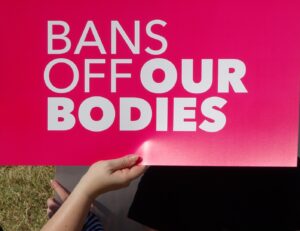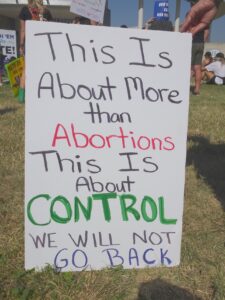
“The post-Roe landscape has exposed a brutal truth: anti-abortion policies are economic weapons that compound inequality. For poor women—especially women of color—the loss of reproductive autonomy means a lifetime of diminished opportunities, health risks, and financial hardship. As data unequivocally shows, the right to choose is inextricably linked to the promise of economic justice.”
Forcing women to carry unwanted pregnancies to term is a public health issue. In states with abortion bans, lack of access to abortion care can be life-threatening when a pregnancy complication occurs. Anonymous: “After the ban, my doctor was afraid to treat my miscarriage. I was sent home twice from the ER with a fever and told to ‘wait it out’ until it became life-threatening. Their fear of the law put my life at risk.” Amanda Zurawski, Texas, was forced to carry a non-viable pregnancy to term after her water broke at 18 weeks, because doctors said the state’s bans prevented them from intervening until she became septic—a life-threatening infection she subsequently developed.
Women denied abortions report worse overall health for years afterwards. They are also more likely to stay in contact with a violent partner, trapping them and their children in dangerous situations.
Economic Ruin and Increased Poverty

Women denied abortions face immediate and long-term financial devastation lasting for years. The landmark Turnaway Study, which tracked women denied abortion care, found they were three times more likely to fall into poverty within six months compared to those who received abortions. They also experienced higher debt, bankruptcies, and evictions. Women denied abortions were less likely to work full-time and more likely to rely on public assistance like SNAP and TAN. However, SNAP benefits will be harder to obtain after the recent passage of the ‘One Big Beautiful Bill’.
Seventy-fve percent of abortion patients are low-income, with half living below the federal poverty level. Federal bans on Medicaid abortion funding force poor women to pay out-of-pocket, in states that have not banned abortions, often over $480, leading to delays that increase costs and health risks. Jenice Fountain of Alabama’s Yellowhammer Fund notes: “Low-income communities aren’t tracking bills… They’re having children they can’t afford, without safety nets.” Makayla Montoya Frazier (21, Texas): “I realized I was pregnant again. I couldn’t afford another child then—physically, emotionally, or financially. … I had to figure out how to pay $900 for the abortion out-of-pocket. That was more money than I made in a month. … This was a really challenging and disheartening experience.”
Health Care Access and Maternal Mortality
Anti-abortion states already exhibit worse health outcomes. They are less likely to expand Medicaid after the birth of the child, and they have higher maternal mortality rates. Black and Indigenous women face pregnancy-related deaths at two to three times the rate of white women. Anti-abortion states often have reduced access to contraception and prenatal care, creating even further hardships.
Criminalization of Pregnancy
States with strict abortion bans have seen a rise in cases where women have been investigated, arrested, and jailed for having a miscarriage, stillbirth, or attempting to self-manage an abortion. Poor women are disproportionately targeted, as they are more likely to rely on public hospitals where providers are mandated to report suspected “suspicious” pregnancy losses to law enforcement. 59% of arrested pregnant women are Black, Latina, or Indigenous.
Systemic Barriers and Structural Stigma
Abortion restrictions are designed to be insurmountable for poor women.
Travel Burdens: In 2023, women in states with bans traveled out-of-state for abortions, incurring costs for transportation, lodging, and lost wages. Low-wage workers, often without paid leave, face impossible choices between employment and care. Anonymous: “We got the diagnosis at 20 weeks. Our state had banned abortion. We had to explain to our parents why we were suddenly going to New York for a ‘weekend trip,’ when we were actually going to end a wanted pregnancy. The ban forced us to lie and grieve in secret.”
Waiting Periods and Ultrasounds: Mandatory waiting periods in a number of states, from 2-3 days, require multiple clinic trips, while forced ultrasounds and misinformation campaigns cause further stress.
Geographic Deserts: Clinic closures in ban states have created care deserts, disproportionately affecting rural and minority communities.
The Trap of Deceptive “Crisis Pregnancy Centers”
For women seeking information in states with bans, a primary source of harm often comes from entities known as Crisis Pregnancy Centers (CPCs). Funded by state grants in many conservative-led states, these centers often masquerade as medical clinics but exist to dissuade people from abortion. Peer-reviewed studies have found they frequently provide medically inaccurate information, overstate the risks of abortion, and intentionally cause delays that push patients past gestational limits.
Educational and Occupational Setbacks
Denial of abortion derails educational and career plans. Women denied abortions are less likely to complete higher education, facing reduced lifetime earnings. For Black women, abortion access increased college attendance by up to 200%. Without abortion, women are pushed into lower-paying jobs or out of the workforce entirely, widening gender wage gaps. Abortion bans cost the U.S. economy $173 billion annually due to lost productivity and earnings. States with bans have lower minimum wages ($8.17 vs. $11.92 in protected states) and weaker labor protections. Natalie, a Missouri woman who sought an abortion in 2010, described the financial precarity she faced: “I had $100 in savings—it took me six months to save. If I hadn’t gotten care, I’d never have become a data scientist or had my daughter later.” Now, with Iowa’s six-week ban, she worries others lack her options.
Intersectional Harms to Women of Color
Systemic racism amplifies the impacts of abortion bans. Women of color are disproportionately enrolled in Medicaid. The Hyde Amendment denies federal funds for Medicaid abortions. Latinas and Black women are less likely to have health insurance than white women. Latina and Black women earn half the wages of white men, making travel and procedure costs prohibitive. Gestational bans and parental consent laws disproportionately delay care for minorities and adolescents.
The Network Of Aid Organizations Offers Some Relief
Many recipients express deep gratitude—relief from organizing financial, emotional, and logistical support when navigating unplanned pregnancies. Fund recipients are often facing urgent, high-stakes personal circumstances: unemployment, health issues, parenting burdens, or lack of insurance. Abortion funding isn’t just financial—it’s transformative: enabling education, career prospects, mental stability, and dignity. Remote clinical support from services like Aid Access provides critical access and reassurance, especially in areas without nearby clinics. These organizations are making a valiant effort to overcome some of the burdens poor pregnant women face:
“Thank you for helping me when I needed it and for your patience. Now that I am stable and on my feet, I just wanted to repay my loan and add a little to help out.” Iowa Abortion Access Fund
“With your help, I am able to have this abortion. … I am ill, unemployed, and receive SSDI. I do not have the means or the funds to have this unexpected/unplanned pregnancy.” Iowa Abortion Access Fund
“I can’t express my thanks for your assistance. I was tormented about being pregnant at my age. … I can now finish school and start my career.” Kansas Abortion Fund
“Thank you so much for helping me pay for my abortion. I am a single mother who is trying her best to take care of her one-year-old and I just cannot afford to have another baby right now.” Kansas Abortion Fund
“I have so much to look forward to in life before I decide to have children. … Your contribution is life-changing.” Kansas Abortion Fund
Brittany Mostiller (35, Illinois): “… abortions are not covered by Medicaid … I had a strict time limit … Thankfully, … I was able to get my full procedure covered, fuel, and lodging between two abortion funding organizations.”
Aid organization are finding that it is hard for them to raise the amounts of money needed to help all who ask for help. Multiple leaders told the Texas Observer they’ve heard first-hand from donors and foundations that philanthropy has shifted to political advocacy groups, candidates, ballot initiatives, and clinics in non-banned states. (Historically, abortion funds already receive just a small fraction of overall foundation support for reproductive rights compared to other abortion-related groups.) “The irony of that logic to me is that you would think the groups that have withstood so many attacks on abortion and found a way to remain resilient and still standing would be the ones you would want to invest in. It’s pretty frustrating,” says Anna Rupani, Fund Texas Choice’s Executive Director. If you wish to make a donation to the National Network Of Abortion Funds, click here: https://abortionfunds.org/donate/
Conclusion
The post-Roe landscape has exposed a brutal truth: anti-abortion policies are economic weapons that compound inequality. For poor women—especially women of color—the loss of reproductive autonomy means a lifetime of diminished opportunities, health risks, and financial hardship. As data unequivocally shows, the right to choose is inextricably linked to the promise of economic justice.
Sources: American Progress, Economic Policy Institute, Guttmacher Institute, NIH Studies, U.S. Senate Joint Economic Committee, NPR.

